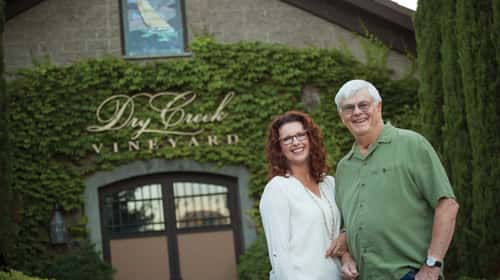This crush season, raise a glass of Sauvignon Blanc and make a toast to passion. But let’s be clear that we’re not talking about those times when the ego wraps itself up in frenzied theatrics and tries to pass off drama as passion. No, let’s toast to that steady fire at the very center of your core, that drives you to get up each morning and perform even the most mundane of tasks and the far-from-glamorous duties with grace and warmth and the knowingness that, come hell or high water, you’re going to follow your heart’s desire.
David Stare, founder of Dry Creek Vineyard, is sitting across from me at his vineyard garden. His demeanor is considerate and responsible, stable and kind. But, if it were not for his passion, this iconic winery would not be celebrating its 45th anniversary; and the Dry Creek Valley would almost certainly not be known for its Sauvignon Blanc, the most planted white grape in the area.
But, before I tell you about California Wine Country and Sauvignon Blanc, let me tell you about Wisconsin and trains.
Early passions
As a child, Stare and his family would pack up each summer and take the long train ride from Boston to Wisconsin to see his grandparents. Was it the melancholy sound of the whistle, the rhythm of the track, the romance and adventure that inspired his passion for trains? Or, was it the time spent with family, on their way to see even more family that caused him to associate trains with happiness? Whatever the case may be, Stare became a train buff and his ambition was to become president of a major railroad. So he made a plan for his education and worked methodically toward his goal. Then, after graduating from Massachusetts Institute of Technology (MIT), he took a job with the B&O Railroad.
“I’ve always been like that,” he says with a shrug. “You put your mind to something and you keep at it until you do it. There’s no big secret.”
With that goal accomplished, Stare put sights to other desires. He had always wanted to live overseas for a while. So, once again, he methodically and tirelessly worked toward that, until he was able to move to Germany. He and his first wife dove into exploring the countryside and learning about the culture. Their weekend excursions along the Rhine and visiting the wineries there sparked an interest in wine. When they returned to the States, Stare followed up on his newfound interest and enrolled in a wine appreciation class.
“That class was my undoing,” he chuckles. Through his friendship with the class instructor, Stare ended up visiting the wine regions of France in the summer of 1970 and falling in love with Loire Valley. “That was it,” he says. “I knew what I wanted. I wanted the life I saw there.”
Once again, he started methodically learning, researching, investigating. His first thought was to move to France and get into the wine business. But, soon after, he saw an article in The Wall Street Journal about the rising status of California wines. Something clicked, and he knew this is where he would find the life that was now calling to him.
“There’s that phrase ‘Go west young man,’ Stare says, leaning across the table. “ I can’t remember who said it. I think it was Horace Greeley, but I knew that’s what I was going to do.”
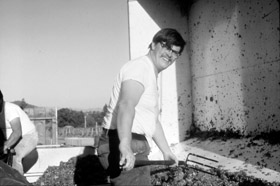 The early days in Dry Creek
The early days in Dry Creek
After arriving in California Wine Country, Stare enrolled in viticulture classes at University of California, Davis and spent his weekends travelling from Mendocino to Monterey searching for the perfect property to start a winery.
“I kept looking and looking, miles and miles around, but I just couldn’t find it,” he recalls. “Then one day, I was in Sonoma County, by the Dry Creek General Store, and everything about this area felt right. And then, I happened to see this man driving a tractor along here, it was a prune orchard at the time, like most of this area was. And I went over to talk with him.”
“He saw that I was trying to get his attention, so he drove to the side of the road. His tractor’s kicking up a big cloud of dirt, and he comes walking out of it and asks me what I want. And I tell him I’m looking for some land. Does he know anyone who’s selling? He stops a moment and says, ‘Well, the lady who owns this property, her husband just died, she might want to sell.’
“So, he gets into my car and we drive over together to go talk to Mrs. Howe. Ten minutes later, on a handshake deal, I became the owner of this property,” Stare says with a broad, beaming smile, his arm sweeping the view. The site became the first winery to open in the Valley following Prohibition, and is credited for the rekindling the growth of Dry Creek Valley and establishing it as a premier wine area.
Once the property was his, Stare yet again started off on his methodical research and the day-to-day work of realizing his dreams. In the process, he called in specialists to help him ascertain which kinds of grapes would do best in this particular soil. According to those experts, Sauvignon Blanc would not fare well in the region.
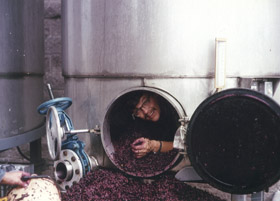 That news did not sit well with Stare. When he had envisioned making a new life for himself in a place much like his beloved Loire Valley, his vision included Sauvignon Blanc wine, a personal favorite. And he wasn’t willing to give up on it. So, against some credible advice, he went ahead and invested in his original idea. And, as it turns out, the Dry Creek earth is spectacularly well-suited to Sauvignon Blanc. So much so that it is now the leading white grape planted in the area.
That news did not sit well with Stare. When he had envisioned making a new life for himself in a place much like his beloved Loire Valley, his vision included Sauvignon Blanc wine, a personal favorite. And he wasn’t willing to give up on it. So, against some credible advice, he went ahead and invested in his original idea. And, as it turns out, the Dry Creek earth is spectacularly well-suited to Sauvignon Blanc. So much so that it is now the leading white grape planted in the area.
“I’m very much in favor of research and experts, but sometimes you have to follow your gut,” Stare says with a grin. And when asked how he feels about making such a good call, the grin broadens, his eyebrows raise a bit, and he simply answers, “Very glad.”
In the early years, Stare worked seven days a week at the winery doing whatever needed to be done. He planted and pruned, promoted and sold, invoiced and phoned and manned the tasting room on the weekends.
“It was difficult and it was busy and sometimes overwhelming, but it was enjoyable in the way that only the really tough work can be.” As is the case with so many new, family businesses, the costs outweighed the profits for a long time, making the business infinitely more tricky.
 Even so, Stare considers himself lucky to have gotten into the industry when he did. Now, wine is big business and only a few companies—Gallo, Constellation and The Wine Group—control almost half of the U.S. market. A handful of others, including Jackson Family, control another big share. That leaves more than 7,500 wineries fighting for the remaining 40 percent of the domestic wine market. Keep in mind, those 7,500 wineries don’t get into Costco and Walmart and the grocery stores, which account for close to half the wine sold in the States.
Even so, Stare considers himself lucky to have gotten into the industry when he did. Now, wine is big business and only a few companies—Gallo, Constellation and The Wine Group—control almost half of the U.S. market. A handful of others, including Jackson Family, control another big share. That leaves more than 7,500 wineries fighting for the remaining 40 percent of the domestic wine market. Keep in mind, those 7,500 wineries don’t get into Costco and Walmart and the grocery stores, which account for close to half the wine sold in the States.
“One of the major changes of the industry over the last 30 years has been distributor consolidation. With fewer distributors handling more brands, it’s hard to get the distributor to pay attention to your brand. I feel fortunate that we have had an outstanding reputation for many years, which certainly helps us sell our wine.”
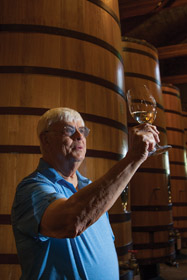 The first four or five years were a struggle, Stare says, but in 1977, things started turning around. “One day in late July or early August I got a call from my CPA to tell me that I finally turned a profit. It was $98. That night, I took a business partner out to celebrate and we spent our entire profit on dinner.”
The first four or five years were a struggle, Stare says, but in 1977, things started turning around. “One day in late July or early August I got a call from my CPA to tell me that I finally turned a profit. It was $98. That night, I took a business partner out to celebrate and we spent our entire profit on dinner.”
As Dry Creek Vineyard picked up speed, the entire Valley started switching over to vineyards. “When we came here, this whole area was pretty much orchards,” Stare says. “There were a few older wineries, such as Pedroncelli. But, nothing new had opened here ever since Prohibition. We were the first. It got things rolling.”
In addition to that, Stare is also credited with spearheading the drive to get Dry Creek Valley designated as its own American Viticultural Area (AVA). “Well, it started off with us making a wine label that said ‘Dry Creek Valley’ and that wasn’t necessarily abiding by the government rules of what a wine label could say,” Stare explains. “So, I thought, well we should make our own AVA, and it kept going from there.”
A love of wine and sailing
That wasn’t the only time his labels caused a stir. Back in 1982, Stare wanted to meld his love for wine with his love for sailing, so he and his daughter, Kim, came up with his easily identifiable labels, featuring sailboats. (Ironically enough, the words “Dry Creek” are now forever linked to the spirit of the high seas.) When Sonoma County artist Michael Surles first created those sailing labels, they were considered rather daring. Back then, all the wine bottles looked the same—serious looking writing, logos, maybe an ink drawing of the winery, perhaps a picture of grapes. And then along came Dry Creek’s beautiful, colorful sailboats and, once again, the winery separated itself from the pack.
The recognizable labels served to get the wine noticed by consumers, yet it never quite became the full-fledged wine of choice within the sailing community. “Oh, those guys have awful taste in wine,” Stare says with a hearty laugh. “They’re always buying those boxed wines so they don’t have to worry about broken bottles. After a while, that stuff tastes normal to them. There’s nothing I can do to help them out with that!” Nevertheless, Stare still loves the sailing community and sponsors many events. The first time he did so was in 1977 when Peter Holmberg, then a Sonoma State University student, approached Stare to ask for help with the school’s new sailing team. Holmberg is now a renowned sailor, Olympic medalist and America’s Cup skipper. And Dry Creek Vineyard is now known for its association with the sport and, among its many other accolades, it was selected as the exclusive wine supplier for the 2016 America’s Cup World Series Races in Chicago and New York.
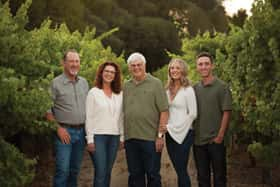 A family business
A family business
Among the many accomplishments Dry Creek Vineyard has enjoyed through the years, Stare says one accomplishment he’s most proud of is that, 11 years ago, the business was successfully passed down to the next generation. It’s also one quality that makes Dry Creek Winery such a rare jewel. These days, after all, a jewel that hasn’t been added to the crown of a wine conglomerate is the rarest jewel of all.
Not many of the larger family wineries get passed down. “The wine business is hard work, it’s not always glamorous, and it’s not necessarily the most profitable business.” And there’s always a big corporation waiting on the sidelines, more than happy to buy up the premium wineries for a good chunk of change. On top of that, running a family winery is not only a job, it’s a way of life. Given the choice between taking over their parent’s lives and carrying on a tradition, or taking a big hunk of money from the sale of the family winery and enjoying their own lives, many people opt for the second.
“I’m very happy that Kim [his eldest daughter], and her husband, Don, chose to carry it on,” Stare says. “They’re doing an excellent job. I mean excellent.” Stare is a family man. He describes his daughter’s accomplishments, and shares some of the cute antics of his grandchildren, and he’s completely animated and joyful as he talks about family.
He leans back in his chair and takes in the view of the vineyard. “This is nice,” he resumes. “It’s been wonderful starting this winery. But now, I have new passions.”
Giving back
Stare serves as the board chairman for Global Partners for Development, a philanthropic organization that funds water and sanitation projects in Kenya, Tanzania and Uganda. His father was a Harvard University professor in the School of Public Health, so Stare always had an understanding of how socio-economic differences influenced personal well-being.
Stare pulls up his pant leg to show me his bandaged calf. “I got a tick bite. Luckily, I don’t have Lyme disease, but it did get infected, so I have to go to the doctor’s periodically for them to clean it out. It’s not a big deal. It’s going to be fine. But if I was somewhere in a third-world country and this happened, there’s a good chance it would be fatal. And when you think of it that way, how a little help can go such a long way there, it makes you want to help.”
The other big passion now is making music. Stare played trombone and banjo back in high school, but he didn’t play for the next 55 years except every now and then. “I’d pull out the banjo when I’d had a little too much wine to drink at a party,” he says.
But once he left the winery, Stare picked up the banjo more and more often. Eventually, he reconditioned it, added a ukulele to his repertoire, and started playing with a Dixieland Combo called The Russian River Ramblers and another band called New Horizons. They’ve performed at the Healdsburg Jazz Festival, the town’s Fourth of July celebrations, as well as various wineries and brew pubs. “Playing music is fun, I love it,” he says. “We practice at a senior complex and often many residents come to listen and occasionally dance to the music. It seems like the highlight of their day.”
Once again, Stare leans back in his chair, and stares off toward the vineyard. “It’s so important to have family,” he says, to no one in particular.


